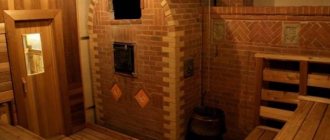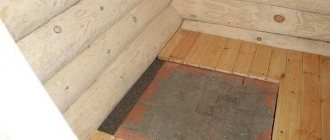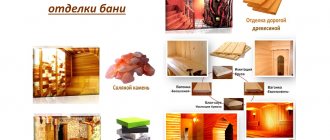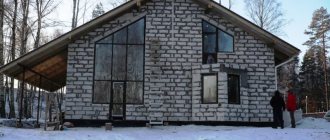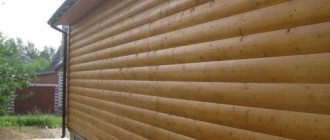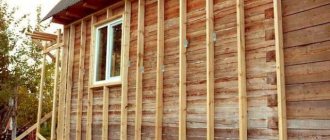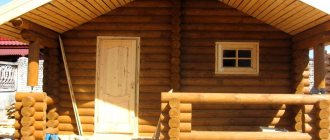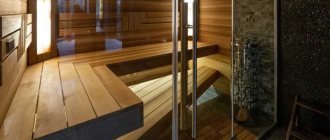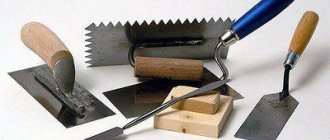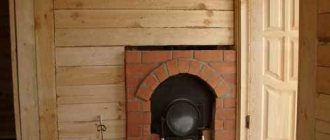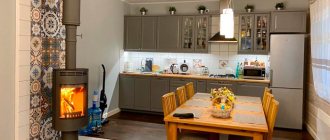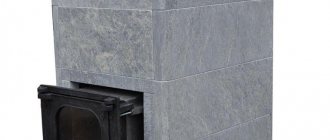Properties of soapmagnesite
Soap stone, hot stone, pot stone, mammoth stone, soapstone - all these are names for one material of natural origin, unique in its properties, namely soapstone.
Hot stone, so popular today, contains a centuries-old history. Almost 3 million years ago, magnesium-containing lava erupted from the depths of the earth, which was carried away from the eruption site by underwater currents. The cooled mineral composition was crushed by continental plates, after which it was subjected to melting and pressing for a long time.
Talkomagnesite: stone texture
As a result, a valuable rock called “Talcomagnesite slate” appeared with amazing properties:
- thermal conductivity. The stone quickly and evenly accumulates heat, after which it can release it for a long time. Thus, after the heating process in a soapstone stove or fireplace is completed, a comfortable temperature in the room will be maintained for up to 36 hours. It’s not difficult to guess how long fireplace stoves with soapstone lining retain heat; of course, such stoves cool down a little faster, but are capable of warming up a room for up to 24 hours;
- heat capacity or the ability to accumulate heat. Talkomagnesite can withstand temperatures up to 1600°C and is 2-3 times higher in heat capacity than kiln brick;
- high density. Due to low porosity and minimal amount of water in the composition. Due to this property, moisture and chemicals do not penetrate deep into the stone, which makes it possible to use this material in damp rooms and clean it by any means;
- strength. Stone products withstand temperature fluctuations; soapstone does not melt or fade;
- ductility or bending strength. Easy to process due to the presence of soft chlorite in the composition.
In addition, hot stone is famous for its healing properties - it produces soft heat that is beneficial for health. There is an opinion that this mineral has special energy; it is used for the prevention and treatment of radiculitis, osteochondrosis, sciatica and joint damage. Therefore, you can often find biostimulants made from soapstone magnesite on sale.
The properties of this rock allow potting stone to be widely used in the production of stoves and fireplaces, it is used as part of facing slabs and floor coverings, the material is also suitable for constructing bathrooms, swimming pools, saunas and verandas, you can even find dishes, grill boards and other items from soapstone.
This rock is mined in Finland and Karelia. And, if the Finns usually use soapstone magnesite in the production of stoves and fireplaces, then in Karelia they also mine a similar rock - soapstone.
Soapstone tiles - what is it and what is its value for a bath
We have already dedicated one article to it, where we talked about its properties and use in a heater. But now this stone interests us as a finishing material . What is the secret of his popularity? First of all, soapstone retains heat well . What else does a steamer need? Of course, there are materials with better indicators (see table here), but then fashion and advertising come into play, and it turns out to be out of competition. And secondly, it’s just beautiful).
Soapstone tiles
Talkomagnesite or soapstone
Two varieties of rock, almost identical in composition, but different in the concentration of minerals. And this plays a decisive role in the use of natural stone in production, because it is magnesite that gives the stone the unique thermophysical properties and strength that a stove should have.
The ratio of minerals in the rock
| Components | Talkomagnesite | Soapstone chlorite |
| Talc, % | 40-50 | 41-46 |
| Magnesite, % | 40-50 | 5-10 (rarely up to 25) |
| Chlorite, % | 5-8 | 30-35 |
| Impurities | Minimal amount | A lot |
An increased content of chlorite in stone leads to serious disadvantages - deformation of products during prolonged heating. This happens due to the evaporation of water from the depths of the stone.
Price is another factor that significantly influences the choice in favor of one material or another. The cost of soapstone is 20-30% lower than the cost of soapstone.
Experts recommend using soapstone chlorite for lining fireplaces, stoves and steam rooms; it can fully cope with this task, and use soapmagnesite, which is heat-resistant and resistant to aggressive influences, in masonry.
How to distinguish soapstone from soapstone?
In order not to fall for the tricks of unscrupulous sellers and to independently determine what material was used, you need to remember two main points:
- soapstone has inclusions and veins in its structure, the surface is lighter. Talkomagnesite is homogeneous and darker in color;
- Magnesite, unlike chlorite, has magnetic properties, and accordingly will attract a magnet.
How much does the material cost?
The price of soapstone for a furnace varies from 3,000 to 16,000 rubles. This difference in the cost of slabs is due to:
- by different manufacturers;
- location of extraction (difficulty of extracting rock, its depth);
- actually, the markup of the store itself
- quality of the material.
Due to the fairly wide range of prices for stove materials, the price of Finnish soapstone stoves will also vary greatly (150,000-700,000 rubles). Much depends on the size of the stove/fireplace. For example, a fireplace about 1 meter high and half a meter wide will cost 230,000 rubles.
Again, there are various manufacturers and sellers who indicate different prices for their goods. However, the assortment of Finnish fireplace stove stores has products with both affordable prices and higher ones. Therefore, a potential buyer has the opportunity to choose a fireplace according to his requirements and preferences.
Operating principle of heat storage fireplaces
A fireplace insert made of soapstone (without a metal firebox) operates on the principle of smoke circulation: flue gases first rise upward and then rush down through special curved channels, thereby heating the entire stove. Soapmagnesite copes with this task due to its ability to quickly conduct and release heat for a long time. And the combustion products, having already cooled down a little, go out into the chimney.
The uniqueness of soapstone fireplace stoves is their high efficiency (efficiency factor) and low wood consumption (lower than standard stoves). For good heating, you need to use about 10 kg of fuel (wood) per 1 ton of fireplace stove. After which the heating temperature reaches its limit and will not rise higher, which means there is no point in wasting firewood.
Advantages and disadvantages
Thanks to the unique properties of soapstone, heating structures have a number of advantages:
- Constant ventilation of the room is not required, since natural materials do not dry out the air. There is also no background radiation, so there is no threat to the human body, but on the contrary there is only one benefit;
- Finnish stone stoves are more durable than stoves made of ordinary red brick due to the lower porosity of the rock (100 times);
- Smoke channels are not contaminated by flue gases, so they can be cleaned much less frequently than the same channels of a traditional fireplace;
- The cost of maintenance remains minimal, since the fuel is burned to an ash-like state;
- High tensile and bending strength allows for thousands of cooling or heating cycles without subsequent formation of chips or small cracks;
- Talkomagnesite has such high strength that it makes it completely waterproof. This way, water that condenses from burning wood and settles on the inner walls cannot seep into the stones and destroy them from the inside.
But there are still disadvantages:
- Building a stove/fireplace on the 2nd floor of a house and above is a somewhat labor-intensive task, since the weight of the foundation laid at the base of the structure is quite large;
- The heating of the fireplace cannot be called fast, and you will have to wait for quite a long time until it starts giving off heat (about 2 hours);
Choosing a fireplace made of soapstone
When purchasing a fireplace made of soapstone, you should pay attention not only to the technical characteristics, but also to take a responsible approach to choosing a manufacturer; the quality and reliability of the heating device directly depends on this.
Talkomagnesite looks very noble and fits well into any interior.
A fireplace stove made of soapstone for a country house is economical and independent heating. Wide selection of shapes and designs (location near the wall, in the center of the room, corner fireplace). You can use both firewood and pellets.
Massive fireplace for a country house
Fireplaces made of soapstone with a stove and oven for preparing culinary masterpieces, because food from the oven has a special aroma and taste.
Soapstone fireplace with stove and oven
Interior fireplaces are suitable for installation in an apartment. Cladding the fireplace with soapstone magnesite for this type is lightweight and does not require additional installation of the foundation.
Interior fireplace made of soapstone
The “Russian stove” is distinguished by its massiveness and functionality. Used for cooking and heating; there are models with a stove bench. Traditional option.
Fireplace stylized as a Russian stove
Individually designed fireplace stoves for luxury housing. Only natural materials and unique design solutions will highlight the interior and sophistication of the room.
Individually designed soapstone fireplace
Trusted product suppliers offer consumers a wide range of models of different designs. In such conditions, it will not be difficult to choose a really good fireplace.
What kind of soapstone stoves does the Fireplace-Sklad online store offer to buy?
Furnaces with soapstone lining are made of steel or cast iron. Sheet steel structures are characterized by better heat transfer. Such models allow you to heat your house faster. Cast iron is a more heat-intensive material. In combination with soapstone, the device demonstrates the highest parameters for heating duration from one fuel load. This combination (cast iron + soapstone) is chosen for heating houses with permanent residence, as well as dachas and small country houses.
We offer cast iron and steel Dovre stoves made in Norway, lined with soapstone with a high magnesium content. The stone used is durable and reliable, has high heat resistance and burnout resistance. This cladding is durable. It is practical in operation and maintenance. Different models demonstrate a thermal power of up to 12 kW, which is enough to provide heat to rooms and houses with a total area of up to 100 - 120 m2.
How to line a stove with soapstone magnesite?
Cladding a stove structure at home is not such a difficult task, and anyone can cope with it if they approach this issue competently:
- First, the stove walls need to be plastered. Before plastering, the work surface is sprayed with water, only then the solution is applied. After it dries a little, start grouting;
- Be sure to prime the surface; the strength of the cladding depends on this step;
- The glue is applied in an even layer, then wavy grooves are made for better adhesion to the stone;
- Direct laying of stone tiles, the easiest option is to lay them out in even rows.
Installation recommendations
When laying a soapstone floor, the same method is used as for ceramic products. The underlying layer is cleaned, dust-free and treated with a primer. Direct laying is carried out on a cement-sand mortar.
In this case, the grade of the mixture should be higher than 150. For ease of work and to ensure evenness, it is necessary to install beacons in increments of no more than 2 m. You should clearly know that the width of the joint between the tiles should not exceed 3 mm.
Often, natural stone coatings become dirty and dusty after finishing installation work. To remove contaminants, water is used, supplied from a hose under a pressure of 2…3 atmospheres. To achieve the best effect, it is advisable to combine hose cleaning with manual cleaning using brushes.
Soapstone for cladding is a universal material used for wall, floor and decorative finishing. It has plenty of advantages - temperature and alkali resistance, water resistance and durability, but there are only two disadvantages.
It is not for nothing that this rock began to be used by humans several thousand years ago. This is due to its distinctive strength, which allowed people to use soapstone to make dishes and statues.
Choosing a stone for room decoration
Due to its temperature resistance, the coating is recognized as one of the best for covering surfaces for various purposes. It is produced in several types:
Brick
The purchase is appropriate if the goal is cladding or flooring work, in particular the construction of heated floors in residential premises or baths, swimming pools, saunas, as well as cladding of stove units, fireplaces, etc.
Tile
Suitable for decorative finishing of walls, niches, partitions, columns, arches, decorative fireplaces. By accumulating heat, it plays the role of thermal protection.
Ragged Stone
This type of soapstone is also suitable for decorative cladding.
Crushed stone and powder are not used for interior decoration.
Popular models
So, what models of soapstone stoves are there? The most reliable and trusted companies producing Finnish storage furnaces at the moment are Tulikivi and NUNNAUUNI.
Heating
If cooking with a stove is not required, then fireplaces are suitable for heating the room. After heating them, they keep the house warm for another day. They can be either wall or corner. They weigh about a ton, so it is better to install them on the 1st floor:
- TU1230 – old school fireplace model, classic. The price is about 300 thousand rubles. Simplified design, no vortex firebox, which makes it such an attractive price. There is a panoramic window.
- TU1450/1 is the most common oven with rounded edges. It combines all the latest Tulikivi technologies. Price 299,900 rubles.
- KTU1410/92 is a stove made entirely of soapstone (including smoke ducts). High efficiency (80%) and heat output 22 hours. And all this for 299,900 rubles.
- TU1000/6 is one of the most economical and environmentally friendly ovens. You only need 7 kg of firewood, and your house is heated for 18 hours. Standard for quality, reliability and efficiency. Price 265,000 rubles.
- KTU1130/3D is a corner fireplace stove that allows you to watch the burning of wood from any angle thanks to the panoramic glass. Price 332,000 rubles.
- JOYA – the large thickness of the stones guarantees the durability of the fireplace. High power of 56.2 kWh. Price 369,000 rubles.
- DEKO is a small fireplace weighing 341-665 kg, however, it has a high efficiency (81%). And for an affordable price - 189,000 rubles.
Heating and cooking
Good stoves for people who love and want to cook:
- TLU2137/13 – small, has panoramic bay doors, if desired, you can bake real delicious bread. Price 549,900 rubles.
- TLU1600/91 – there is an oven, the smallest wall-mounted fireplace stove model. Price 459,900 rubles.
Design of soapstone furnaces
Soapstone has a gray-green color and a beautiful structure, so stoves made from this stone are very decorative. The surface of the stone is carefully polished and is often a combination of minerals of different structures, which gives stove models extraordinary originality. The style of such stoves is mainly modern, characterized by clean geometric lines and laconic design.
The classic version of steatine stoves may include a massive body with a cooking zone or stone beds, which also heat up to a comfortable temperature when the device is operating.
How to choose?
For home
When purchasing a heat storage fireplace, you need to remember important points:
- location of the combustion chamber and its volume;
- what is the fireplace surround made of?
- How long does the fireplace run while maintaining the temperature? The best option for your home would be a Finnish fireplace stove with a long burning time. You often need to add firewood to such a stove only when the room is heating up, then you can add fuel once every 8-10 hours;
- room volume. To calculate it, the height of the ceilings is multiplied by the area of the room, not forgetting to take doors and windows into the “reserve”. To determine the performance of the fireplace, the resulting number must be multiplied by 1.5 if the fireplace stove will be installed in an area with predominant cold winters.
You also need to carefully read the operating instructions for your purchase once all the installation criteria have been determined, and all that remains is to decide on the choice of the desired model. It contains rules for installation and subsequent use, technical specifications and some features.
For a bath or sauna
Soapstone stoves are an ideal option for a sauna. When choosing a sauna stove, you need to consider the following specifics:
- It is better if the stove has a massive transparent bath glass through which you can observe the heating process;
- combustion channel length;
- what kind of stone will line the stove;
- Is the stove equipped with special screens (protection) against fire?
Operating principle of soapstone furnaces
Soapstone ovens operate on the principle of radiation, i.e. heat is accumulated by the soapstone and dissipated into space in the form of infrared radiation, which heats all solids in the room. Thus, this type of heating has many advantages, for example, maintaining optimal air humidity, the absence of air flows of fine dust that is formed during the convection heating method, which is very important for asthmatics and people with dust allergies.
Soapstone stoves are safe, economical and long-lasting heat.
Other advantages of infrared rays relate to their ability to penetrate the skin over a distance of approximately four millimeters, and this, in turn, has a positive effect on blood circulation, reduces hypertension and reduces joint pain. At the same time, cellular metabolism improves, affecting the production of hormones that delay the aging process of the skin.
The complete wood combustion cycle of soapstone stoves reduces the content of carbon monoxide (carbon monoxide) to a minimum, and the absence of mechanical and electronic components reduces operating costs for expensive repairs.
